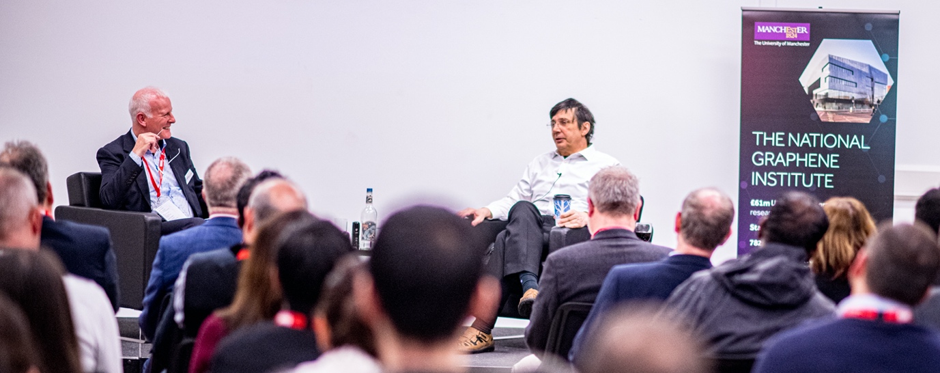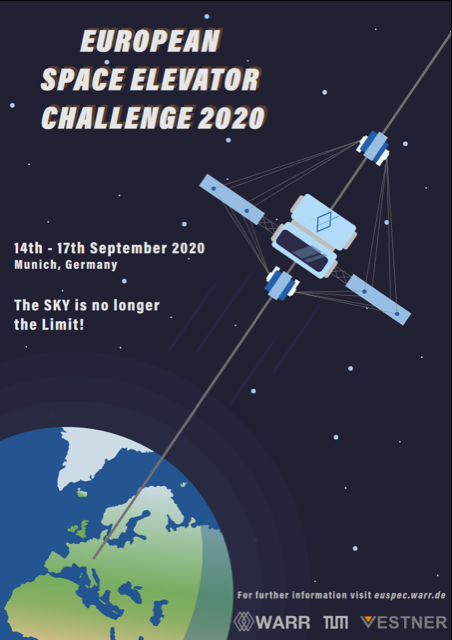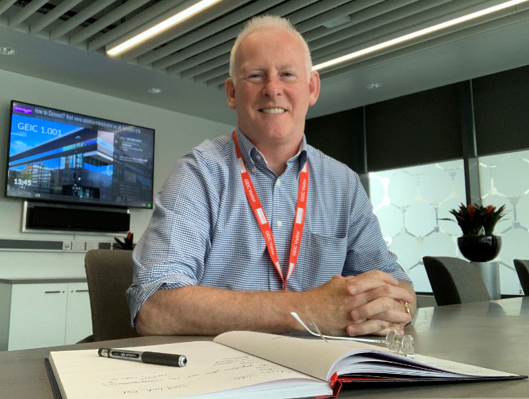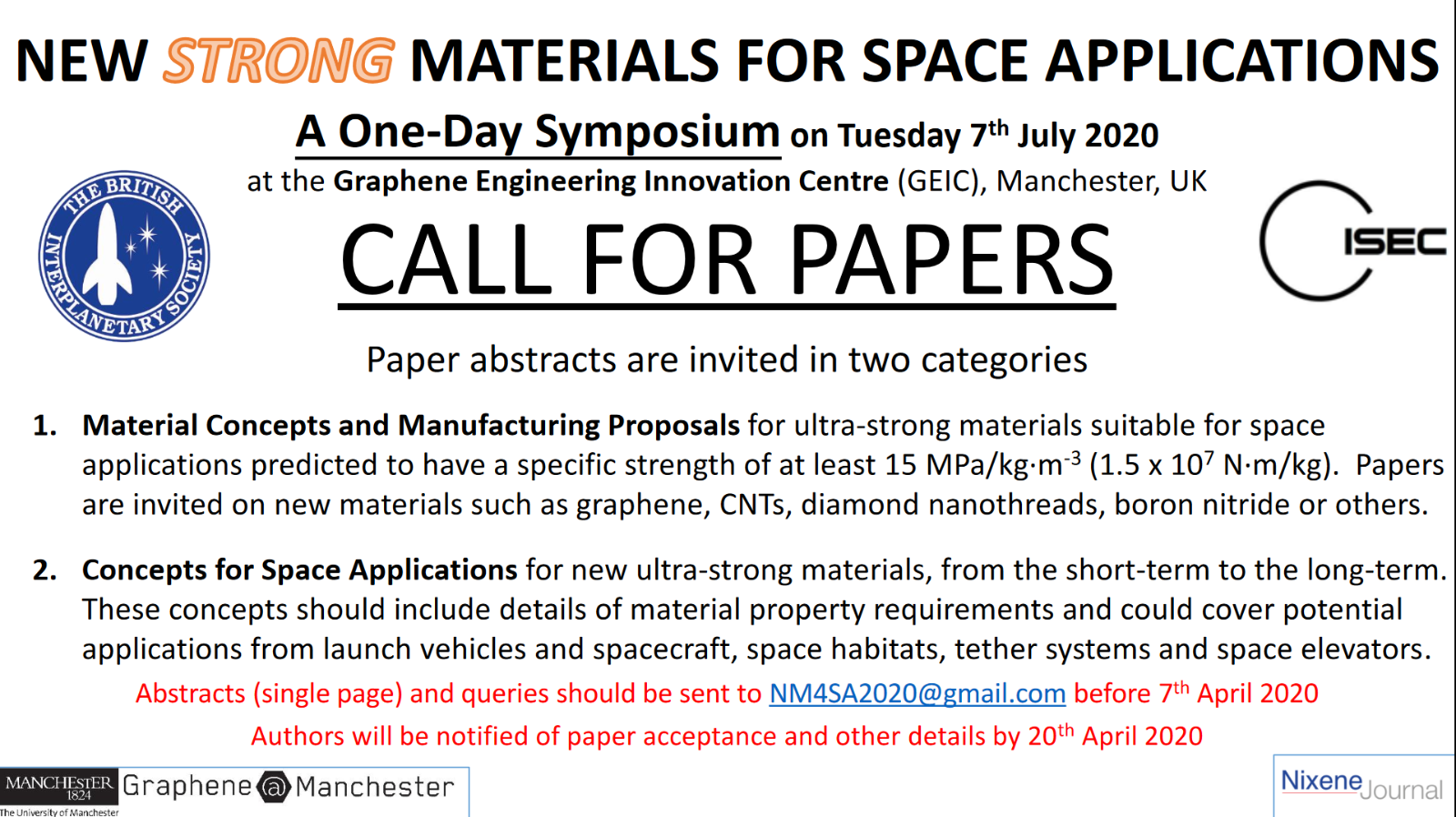|
Welcome to the February 2020 Edition of the ISEC Newsletter
In this Issue:
Editor’s Note
President’s Corner
Architecture Note
Interview with Andre Geim
European Space Elevator Challenge
Report from the ReInventing Space Conference
2020 Vision for the Space Elevator
News from the GEIC
New Strong Materials for Space Applications
History Corner
Summer Internship
Upcoming Events
Dear Fellow Space Elevator Enthusiast,
Have you ever read an email from someone with “NP” at the bottom as a postscript meaning “now playing” to let you know what music was playing in the background while it was being typed? My music-loving friends and I used to do this all the time. See below for what popped up on my internet radio site while working on this newsletter!
In the August newsletter, Pete Swan told us that Elon Musk intends to send a million tons of material to Mars. There were no articles to provide for you at that time, but now, futurism.com and Space.com have published articles this month about this endeavor:
https://futurism.com/the-byte/elon-musk-million-people-mars-2050?fbclid=IwAR0sz-MH-hsFhV4oGzkxG5LLSEWXHKTtuQHxnoQoVJ5qELPeYRf8z6kUc48
https://www.space.com/elon-musk-starship-spacex-flights-mars-colony.html
Remember, you read about it here, first! (Eight months ago! But who’s counting?)
Please like us on Facebook, follow us on Twitter, and check in on our website for updates.
Sandee Schaeffer
Newsletter Editor
NP: “Rocket to the Moon” by Jim Brickman
Maybe one day we can get him to compose a piece and dedicate it to the Space Elevator?
President’s Corner
by Pete Swan
Traits of Entrepreneurs
As I have done in the past, I am quoting Peter Diamandis' email blog, [Diamandis, Peter, “Entrepreneurs-in-the-Making: Are you Ready to Take the Leap?”, email 19 Dec 2019.] this time on characteristics of entrepreneurial types. In the book "Traction" by Gino Wickman, the six essential traits are explained (shortened for newsletter) as shown below.
1. Visionary: Perhaps one of the most innate traits—and therefore the most difficult to teach—is vision. Involving far more than mere ideas, being visionary requires connecting the dots between seemingly disparate business problems and unlikely tools.
2. Passionate: Nowadays, the term “passion” is often nonchalantly thrown around as a sentiment akin to strong interest or personal investment. But a truly successful entrepreneur must be passionate about one’s product or service to the point that it fills an almost existential void. This involves an unshakeable belief in the value and necessity of one’s venture— one that fulfills and grants purpose.
3. Problem-solver: Gino expresses the belief that entrepreneurship is innate: a trait of nature, not nurture. Challenges are exciting opportunities, not setbacks, and an entrepreneur’s natural response is optimism rather than discouragement.
4. Driven: Many of us are driven by external rewards, a paycheck, or the extrinsic motivation granted by a boss, parent, professor, or organization. The best entrepreneurs, however, fuel themselves with an intrinsic motivation to competitively overcome failure after failure, matching enthusiasm with endurance and a sense of urgency.
5. Risk-Taker: In many ways, risk aversion is the enemy of entrepreneurship. Another hardwired trait, a risk-loving mentality is key to rapid iteration, failing forward, and an entrepreneur’s investment in seemingly crazy ideas that revolutionize entire industries.
6. Responsible: At the same time, however, entrepreneurs must be responsible in both risks taken and venture management. Always remaining accountable.
As I read through this list, I recognized that our board of directors has many of these traits with some running across all of us. I think the two that are dominate within ISEC are Visionary and Passionate. Why else do we volunteer to "run" the major efforts on space elevators? As such, we are a unique and powerful group with a vision to improve the human situation with an inexpensive, permanent infrastructure, daily liftoffs, environmentally friendly approach to liftoffs to space. One characteristic I see in our Board of Directors is "hope for the future." Yes, an exciting future exists in each our minds.
home
Space Elevator Architecture Note #29
by Michael A. Fitzgerald
Senior Exec VP and Co-Founder
Galactic Harbour Associates, Inc
Space Elevator Transportation & Enterprise Systems
Personal Prolog
This is an Architecture Note. It is the opinion of the Chief Architect. It represents an effort to document ongoing science and engineering discussions. It is one of many to be published over time. Most importantly, it is a sincere effort to be the diary, or the chronicle, of the multitude of our technical considerations as we progress; along the pathway developing the Space Elevator. -Michael A. Fitzgerald
Space Elevator Architecture’s “Call for Improvement” Approach
Sub - Topics:
-
- Things Change
- Improving the baseline
- The importance of a System Performance Simulator
- Configuration Control responsibility
Things Change
Sometimes it is hard to notice, but things change! As stewards of all things Space Elevator, it is our job to keep all that change stuff under control, and yet engender all the changes we can until we get the Space Elevator just right, just the way we want it. Whew! My intent here is to establish enjoyable stewardship, with a sufficient amount forward momentum.
First of all, let’s delineate the notion of the Baseline. Right now, we have one baseline for the Space Elevator Transportation System, the concept baseline. It is what we have declared as “Tech Ready” as we exit the first phase of our development maturity roadmap. As we enter the Engineering Validation phase, ISEC will begin considerations of the engineering baseline and stimulate industry to get involved. This baseline reflects our understanding of how to build something that matches our concept baseline vision.
As ISEC (and industry!) continue examining the engineering; they will come headlong into solid queries of what is this Space Elevator Transportation System thing going to do; and for whom. As those forces meld with each other, clients and customers will levy their requirements and their needs on the Space Elevator Transportation System. A requirements baseline will take form.

Finally, as we exit Engineering Validation Phase, the engineering baseline and the requirements baseline will merge; and the Design Baseline will be carried forward into our Third phase.
At that moment, ISEC and a few industry players, will have (in their view and in their memories) the baseline structure of the Space Elevator Transportation System and its legacy. The concept; the technology, the engineering, the requirements, and the design baseline; all of it. Proud as we all might be - we must also see how to improve it; starting now.
Improving the baseline
It is a bit like saying that we love our kids, and this is how they can be better. In fact, if you were to listen in on ISEC board meetings, you would hear just that --- how to make the Space Elevator Transportation System better. We all should realize that “understanding” is most always the best first step to improvement. So, in our role as stewards, we must foresee that moment at the end of the Engineering Validation Phase.
Whomever leads us into Design Validation must glean, from all the baselines, all the improvements hidden there. That leader will call for them to be brought forward. From the concept – the technology. From the engineering -- the test data. From the requirements -- the purposes. All of that will be brought forward in response to the “Call for Improvement”; with new configurations linked.
To some extent, the call has already been issued. We are hearing some sort of “fore-echo” of the Call. John Knapman leads a team empirically examining a new lower portion of the Tether, and a different interface at the connection to Earth. The Multi-Stage Space Elevator had a singular beginning – proposing that we proceed even if the Single Crystal Graphene solution never matured. John’s fine efforts now show that a platform configuration “at altitude” has merit for other purposes.
In addition, discussions regarding how the Space Elevator Transportation System should fare in the face of the space debris, has given birth to lower altitude multi-leg tether configurations. The incorporation of a platform just above the debris regions could inspire new requirements. Pete Swan will discuss the multi–leg in the debris report due out in February 2020.
Further improvements will be identified over the coming several years and moved into the design baseline when matured. We see Space Elevator Transportation System improvements for overall logistics throughput, for support to interplanetary travel, research, tourism, and a range of enterprise support specifics.
The Importance of a System Performance Simulator
The whole notion of the “Call for Improvement” process is that the Space Elevator Transportation System is … improved. In that spirit, we need to define some standard metrics, and some specific metrics; and then determine how those metrics will be measured. This isn’t as easy as it might seem, and the simulator that is capable of assessing whether an engineering improvement provides improved requirements satisfaction will be a challenge.
Configuration Control responsibility
In the spirit of the classic cynical commandment that “no good deed goes unpunished”; the Call will have some level of bureaucracy. Most of the bureaucracy will be to ensure that the Space Elevator functional configuration is not lost or diminished; all segments must work together.
The System has 6 segments and each segment interfaces to one or more of the other segments. That configuration will stay the same until the system design activity begins. The 6 Segments are:
1. Earth Port
2. GEO Region
3. Apex Region
4. Tether
5. Climber and
6. HQ/ POC
So, our scheme is to gather improvements during Engineering Validation phase; and reconfigure later. In fact, a Call for a “System Re-Configuration” is almost certain; (been there).
In closing,
As far as we have come, we are just getting started. The Space Elevator Transportation System is becoming an essential part of space transportation and the space infrastructure of the 21st Century. A little improvement is a good thing; and even necessary to match these endeavors.
Fitzer
home
In conversation with Andre Geim at the National Graphene Institute
Professor Sir Andre Geim is repeatedly named among the world’s most active scientists by Thomson-Reuters. He is continually making an impact with ground breaking research. He is the only person ever to have been awarded both the Ig Nobel and Nobel prizes (both for physics). He rarely gives interviews so this was a treat.

Professor Sir Andre Geim. Image courtesy of the University of Manchester
Here are some highlights from his conversation with me and members of the audience…
Why do you think graphene has gained so much prominence?
It is a material of surprises and superlatives. As well as being the thinnest, strongest, most highly electrically and thermally conductive material ever discovered, we can also add it is the quickest to market. We first started to see graphene in sports equipment such as tennis racquets & skis, although many thought it was mostly a sales gimmick. Now we are seeing more realistic applications as graphene is being added to improve mobile phones, batteries, paints and car components.
What is your view of the landscape of this whole field of research?
Graphene is only one of a whole new family of two dimensional (2D) materials. We know of over a thousand more. The exploration of these has only just begun. An example of these materials would be boron nitride (hBN) which is similar to graphene but instead of carbon it is made of alternating boron and nitrogen atoms. Molybdenum disulphide (MoS2) is another of these 2D crystals and has a range of properties that make it a promising candidate for future electronics.
As well as understanding the properties of these new materials we have learnt how to combine them in layered stacks called van der Waals heterostructures. The number of potential combinations is practically endless. The 2D materials and their heterostructures will keep us in work for decades to come.

Adrian Nixon in conversation with Andre Geim at the NGI. Image courtesy of the University of Manchester
You mentioned graphene is a wonder material, can you tell us more?
To everyone’s surprise, graphene continues to reincarnate itself every couple of years. Most recent example is bilayer graphene where layers are rotated slightly (about 1 degree) relatively to the other. This rotation makes graphene superconducting when cooled down to 2 Kelvin. This came as a genuine surprise, no one expected or predicted this. People are still working to understand the mechanism involved. The research has the name twistronics, an emerging field that explores effects of aligning atomic layers within van der Waals heterostructures at different angles. This is going to keep scientists occupied for many years.
Are you working on other aspects of 2D materials?
Let me give you the latest example of Manchester research developed over the last 3 years. When an atomic layer such as graphene is removed from its bulk crystal, people focused on the material that had been isolated, graphene or another 2D crystal. We changed the perspective asking ourselves what properties would be of what is left behind. It is an empty space of only a few angstroms in height.
These 2D voids can be used as, for example, nanocapillaries and exhibit quite unusual properties as we found. They allow some molecules, like water, to pass through. Other, larger, molecules and ions cannot. This mimics the basic elements of life, protein channels such as aquaporins. Using the 2D empty space we can now explore the behaviour of gases and liquids under the true atomic-scale confinement, which is important for many things in science including our understanding of the complexities and functioning of life.
Amazing, thank you Andre. You have given us an insight into Nobel prizewinning thinking. Long may you continue to explore and fascinate us with what you find.
home
Announcing:

home
Report from Reinventing Space Conference (RIS)
by Peter Robinson
I gave a talk entitled “Space Elevator History, Status and Future” at the 17th ReInventing Space Conference in Belfast, UK, on 13th November 2019 to an audience including many space professionals. It was difficult to condense this subject matter into the allotted 20 minutes, but I mentioned the early work of Artsutanov and Pearson, the ongoing work of ISEC and Obayashi and others, and speculated on the future technical path towards an Earth Space Elevator. (This last speculation reiterated my ideas on technology readiness level (TRL) growth presented at IAC2018, diverging from current ISEC thinking).
2020 Vision--The Year of Vision and Visionaries
by Vernon Hall and Michael Fitzgerald
Co-Founders
Galactic Harbour Associates, Inc
Space Elevator Networks
A Descriptive Encyclical as an unabashed open letter
“The Space Elevator enabled network of Galactic Harbours”
2020 Vision. It sounds like a diagnosis from your optometrist; but it isn’t. It is what the Space Elevator, the Galactic Harbour, is becoming. Our 2020 Vision is a portrayal of the fulfilled transportation story of the 21st Century. It is the extension of our experience; the manifestation of humankind’s initial expansion into the rest of the Universe. This is an unabashed explanation of what we see with 2020 foresight.
An architectural engineer is a system engineer with vision. You have to completely rebuild a modern harbor to understand the “mega” part of megaproject. The co-founders see a network of space elevators as a visionary megaproject and that is the culmination of our vision.
In the broad field of Transportation Systems, the 19th and 20th Centuries saw evolutionary advances in the movement of cargo and people across vast distances. In the United States, the opening of the Transcontinental Railroad in the 1860s brought expansion and opportunity while making such systems as covered wagons, pony express and even “around the Horn” sailings obsolete. In the early 20th Century, gasoline powered automobiles and trucks led to development of roads and highways that expanded into the Interstate Highway System in the 1950’s. In this same era, visionaries developed the concept of Intermodalism based on standardized shipping containers; soon becoming the worldwide Containerization system. That system remains the primary mover of large cargo volumes across the face of the Earth. In the 1970s, FedEx developed its system of specialized Air Cargo planes that revolutionized the movement of consumer goods.
By the middle of the 21st Century Galactic Harbours will provide a nexus for connecting these two dimensional transportation systems of rail, highway, shipping, and air to the third dimension; and provide a safe, reliable and cost effective means to move material and people into orbit and beyond.
Earth’s Galactic Harbours
We see a network of diverse elevators, spread around the earth; but they differ by more than location. Their respective engineering differs by their purpose. Cargo transshipment and vertical cargo transport are common to each, but the Harbours are optimized for their respective specific purposes.
- GEO Orbit factory support
- Space Based Solar Power
- Satellite servicing – Refuel, repair, upgrade
- Assembly of large spacecraft and space facilities.
- Other on orbit enterprises
- Interplanetary travel support
- Flight Systems final assembly
- Departure Mission readiness and checkout
- Departure and arrival operations
- Fueling special thrusters for long distance operations
- Massive cargo and material handling operations
- Sensing Systems
- Flight operations within the Elevator regions
- Computers
- Testing and test data collection facilities
- Human rated activity
- Elevator region flight operations
- Safety and Comfort
- Space and Region debris mitigation
- Space Traffic Management and Control
- Law enforcement
- First Responders
- Safety assurance operations
- Sovereign issues and relations
Some of these elevators are stand alone, and some are hybrid elevators sharing the operational regions with one another. To some extent the “Government elevator” is embedded in all elevators. Travel from one elevator to another is on enhanced pathways along and across the geosynchronous belt. Trade between the elevators is robust; especially for delivery of key repair items; FedEx and UPS aloft.
Some of the elevators are human rated and some are purely robotic. Some are small and speedy, and some have immense throughput.
The Solar System’s Elevators
The purposes of Earth’s Space Elevators are to 1) deliver cargo to the Enterprises assembling along the geosynchronous belt near the Space Elevator’s GEO Regions; and 2) support interplanetary flights from the APEX Regions; to the Moon, to Mars, and elsewhere.
Since the interplanetary flights from the Apex will use the latent ΔV, (derived from Earth’s rotation - transformed into radial speed at departure from the Apex); Space Elevators are established around the Solar System as part of the Galactic Harbour transportation network. Elevators operate near the Moon, on Mars, on key asteroids within the asteroids belt and elsewhere. We see immense cargo craft moving from Elevator to Elevator bringing supplies and equipment; and returning with raw materials for processing in one of the several GEO regions and later to Earth. This is the third dimension of trade, commerce, transportation, and humankind.
The Network – Earth’s lifeline to the future
The magnitude of this portrayal is humbling. It will be accomplished in the time to come. It is a well-marked destination; marked by the needs of humanity. It was seen before; yes, seen by those who preceded us - and it will be built by those who follow.
home
News from the GEIC
by Adrian Nixon
That’s the coolest business card I’ve seen…
That’s what the journalist said who interviewed us at the GEIC, in the UK.
I’m with James Baker, CEO of the Graphene Engineering Innovation Centre (GEIC, pronounced like ‘geek’) in Manchester, UK. The GEIC is where academia and industry meet to test and develop exciting new applications and products made with the wonder material, graphene. Some of the world’s top scientists work here. It’s an exciting place to be.

Adrian Nixon in the boardroom at the GEIC
James and I were being interviewed for a podcast by award winning journalist Tom Whalley, he came straight from the British Broadcasting Corporation (BBC) to visit us at the GEIC. As well as producing programmes for the BBC he also has a high-profile podcast that speaks to people in the world of cycling.
Now at this point you may be thinking cycling? Bear with me. It turns out that the world of cycling is really big business, particularly in Europe but also around the world. The professionals and serious amateurs are really into their tech. The cycling world is one of the early adopters of graphene technology. The athletes have realised that graphene makes the difference between winning and losing. Graphene rubber composites are in the bike tyres. All the time trial winners of the major races won on graphene tyres. Tom was interviewing James and Me to find out what else graphene can do. So, we dived in with a double act and rather impressed him with what we see coming out of the labs and into real world products.
Then, towards the end of the interview Tom said, “I’ve heard that graphene can do something for the Space Elevator, can you tell me about that?” That really surprised me, Tom is one of the more remarkable and well-informed journalists.
So, I told Tom how the Space Elevator works. He now knows that all the components for the Space Elevator are do-able with today’s technology. The remaining problem is to find a material strong enough and long enough to make the tether. Then I told him about the process we have proposed to make graphene in continuous sheets. The space elevator is closer than people think. “Wow! That’s definitely going to make the cut,” he said.
Oh, and the coolest business card? Normally people say that when they meet James Baker. This time it was mine:
Adrian Nixon
Member, Board of Directors
The International Space Elevator Consortium.
It’s good to be reminded when I have my head down in my work that I’m doing really cool and fun stuff with impressive people these days!
home
New Strong Materials for Space Applications
a One-Day Symposium
Date: 7th July 2020
Venue: Graphene Engineering Innovation Centre, (GEIC) Manchester, UK
Graphene and other new materials will transform engineering in many fields, with news of innovations almost daily. This symposium will focus on the highly promising field of graphene variants and other materials with a very high specific strength, perhaps an order of magnitude or more, stronger than the strongest commercial materials today, with an emphasis on outer space. Such new ultra-strong materials have the potential to transform space and terrestrial applications, with exciting possibilities for the short and long term.
The one-day meeting will consist of two sessions:
- New strong material concepts. What potential materials with high specific strength are under development? When will they be available? Are their properties suitable for the arduous space environment (for example, from cryogenic to incandescent temperatures)? Could they be manufactured readily in space?
- Space applications of new strong materials. Short-term, how might new materials influence the design of launch vehicles and other spacecraft? What other vehicle concepts might become feasible? Longer term, how might new materials lead to the feasibility of large-scale space habitats, tether systems and space elevators? What else might become possible?
The symposium will be hosted by the Graphene Engineering Innovation Centre (GEIC) in Manchester, UK, in association with the British Interplanetary Society, the International Space Elevator Consortium and Nixene Publishing.
GEIC is one of the leading world centres for graphene research: meeting attendees will be offered a tour of the facility.
Registration will open in April 2020.

home
History Corner
by David Raitt
The Contribution of Arthur C. Clarke to the Space Elevator
This essay for the History Corner shows the influence that Arthur C. Clarke has had on the space elevator. His name crops up many times whenever space elevators have been mentioned in the past as well as the present. This is the second part of two parts due to length. For the first part, please see the Dec 2019/Jan 2020 issue.
In Clarke’s later novel, 2061: Odyssey Three, published in 1987, the possibility of a space elevator is realized after a groundbreaking discovery that Jupiter's core (now in fragments around the orbit of Lucifer, the small sun formed by the implosion of Jupiter) had been a solid diamond. As the hardest substance in nature, suddenly available in vast quantities, it facilitates the construction of a solid elevator rather than the more common tether structure previously envisaged. In Clarke’s fourth and final book, published in 1997, in his Space Odyssey series, 3001: The Final Odyssey (Clarke, 1997), four gigantic space elevators are located evenly around the equator. The story follows the adventures of an astronaut murdered by HAL in 2001: A Space Odyssey who is brought back to life. The astronaut then explores the Earth of the year 3001, one of the notable features of which is a large network of space elevators and habitats in Earth orbit.
Actually, Clarke had written a short story much earlier in 1958, which was only published under the same title as a novel in 1986. The Songs of Distant Earth tells the story of a utopian human colony in the far future which is visited by travelers from a doomed Earth, as the Sun has gone nova. Although the term space elevator is not used, the story describes a kind of very strong cable that is used to pull massive blocks of ice from the surface up to a spaceship in orbit around a fictitious planet, Thalassa.
The Web Between the Worlds by Charles Sheffield describes the construction of a space elevator and the novel was published at the same time (1979) as Clarke's Fountains of Paradise. A recent paperback edition of the story includes a contribution from Clarke on the history of the how the idea was brought to press, and a long appendix detailing the physics involved in building a beanstalk (Sheffield's name for the elevator). In his introduction to the Baen Books edition of his novel, Sheffield said that Clarke sent an open letter to the Science Fiction Writers of America, stating that coincidence, not plagiarism, lay behind the fact that two books were to be published in 1979 with strikingly similar themes.
In the 1990s NASA was researching a wide variety of breakthrough space transportation concepts to bring down the cost of launch into space and was investing in many technologies, systems and infrastructures with significant development funding. It is interesting to note that in the ‘Further Reading’ section of a NASA Technical Report, dated 1 January 1992, on tethered satellite systems Arthur C. Clarke’s 1981 paper “The Space Elevator; ‘Thought Experiment,’ or Key to the Universe? is listed - the first mention of a space elevator by NASA..
All the later major players in the space elevator field, such as David Smitherman and Brad Edwards and others, were influenced or inspired to a certain extent by the ideas and writings of Arthur C. Clarke. The modern era of space elevator development was initiated by David Smitherman of NASA after he had read an article on Fullerene nanotubes appearing in American Scientist in 1997, which noted Arthur C. Clarke’s description in Fountains of Paradise. Smitherman realized that if the promise of carbon nanotubes came about there would be tremendous potential for space tethers and space elevators.
Shortly after Smitherman published the results and papers of a workshop he organized in 1999 (to which Arthur C. Clarke was invited but had to decline because he was overwhelmed with projects and also wheelchair-bound), NASA prepared a news item, published on 6 September 2000, which suggested that NASA scientists were seriously considering space elevators as a mass-transit system for the next century. The news item also covered Smitherman’s plans that could turn such an elevator from science fiction - as envisioned by Arthur C. Clarke - to reality in 50 years or so.
Also in 2000, Brad Edwards published the results of a six-month study, financed by NIAC, into the feasibility of a space elevator. Titled simply The Space Elevator, the NIAC study report contained the results of his investigation into all aspects of the design, construction, deployment and operation of a space elevator. The report mentions the earliest people who conceptualized it in their writings and here Arthur C. Clarke is included. In this Phase I Final Report for NIAC, Edwards provided a brief overview of how he thought of using carbon nanotubes for his concept of the space elevator. He noted that Arthur C. Clark had put together an interesting tale of the construction of the first space elevator in Fountains of Paradise and pointed out many of the basic aspects and challenges of building a space elevator and keeping it operational, even if the model for building a space elevator in reality was not really within the realm of practicality.
Edwards’ second book (co-authored by Philip Ragan in 2006) entitled Leaving the Planet by Space Elevator had a Foreword by Sir Arthur C. Clarke who noted that Brad Edwards was presented with the Arthur C. Clarke Innovator Award 2005 by the Arthur C. Clarke Foundation. He also goes on to mention that co-author Phil Ragan had identified Perth, Western Australia as an ideal space elevator base and this idea was incorporated in the novel Sunstorm that Stephen Baxter wrote in 2005 based on Clarke’s ideas and drawing on material included in Leaving the Planet by Space Elevator (in fact, Clarke appears to be the first-named co-author of the novel - and again on a second novel with Baxter entitled Firstborn, published in 2007, which mentions the ‘Aussievator’ - a space elevator being built in Perth.)
The 2nd Annual Space Elevator Conference which took place in Santa Fe, New Mexico from 12-15 September 2003, opened with an introductory talk by Sir Arthur C. Clarke in Sri Lanka via a live video link connection. Clarke discussed the coverage the space elevator was currently getting in the press, addressed the topic of space debris, and gave his opinion on various technical aspects. All who were present agreed with him that it was time to get serious.
The space elevator was one of several concepts singled out for attention in ESA’s ‘Innovative Technologies from Science Fiction for Space Applications’ study. The enormous public interest in this study stimulated the idea of a science fiction essay competition named in honour (and endorsed by them) of Arthur C. Clarke and Ray Bradbury. The theme of the 2nd Clarke-Bradbury Science Fiction Competition, announced in late 2004, was space elevators and several of the entrants in the two categories of story and artwork said they had been inspired by the works of Arthur. C. Clarke - indeed the runner-up painting in the image category depicted an elevator car named the ‘Clarke Clipper’. In another nod to Clarke, the imaginary Clarke’s Town is the setting for “Payload” - a short film produced in 2011 about scavengers in a space elevator town. And a video entitled ‘Arthur C. Clarke’s Space Elevator’ featuring Michael Laine, of LiftPort, not only reviewed his ideas of a space elevator, but also included commentary from Arthur C. Clarke himself.
This short overview has provided an insight into Arthur C. Clarke’s thinking and work regarding space elevators and the lasting effect his name still has.
home
International Space Elevator Consortium (ISEC)
Announces a Summer Internship Program
Deadline -- 30 April 2020
ISEC will have an internship program this summer to stimulate research inside the space community with the purpose of improving the Body of Knowledge on space elevators. The expectation is that the intern would work from home, putting in approximately 10 hours a week researching various components of the space elevator while working with an ISEC mentor. The selection will be competitive with the top several gaining internships. The details are as follows:
•Process: Apply, be connected with the appropriate ISEC mentor, select topic of interest, conduct individual research, confer with mentor every two weeks, interview local space professional, summarize research, present to mentor/and-or at the ISEC Conference.
•Who: This program is open to all undergraduate students. The program is best suited to Freshman and Sophomores working in a scientific or engineering field, however students from all areas of study are encouraged to apply as ISEC works on all aspects of the Space Elevator challenge from technical engineering problems to questions of Space law and economics. We will be accepting several interns for Summer 2020.
•Where: the intern will conduct Research remotely with meetings by Skype or equivalent. The internships final meeting will either be over Skype or at the ISEC Conference.
•What: Interns will be researching or assisting with ongoing research of one area of Space Elevator development. Areas of research include Space Elevator History, Materials Applications for Space Elevator tethers, Earth Port infrastructure, and more. Interns will report progress regularly to their mentor and produce a summary of their research, as per agreement between intern and mentor. They will present this research in person, by Skype or through a video. A list of research papers is available on website: www.isec.org
•Benefit: In addition to the unique opportunity to work with leading Space Elevator researchers each intern will be awarded a $500 grant, an ISEC certificate of completion, and a letter of recommendation.
Key Dates:
Application due: April 30th.
Internship period: June 15th - August 15th.
To Apply: Please submit your application and any questions to inbox@isec.org by April 30, 2020.
Your application should include your name, school, year, major [and interests], and a short summary of your interest in ISEC and why you would like to have a career in the space arena (no more than 200 words).
home
Upcoming Events
International Space Development Conference (ISDC)
https://isdc2020.nss.org/
Thursday, May 28th through Sunday, May 31st, 2020
Embassy Suites by Hilton Dallas-Frisco
Dallas, TX, USA
ISEC will have a Space Elevator track on Thursday starting at 10:00 AM and continuing until 5:00 PM
New Strong Materials for Space Applications
Tuesday, July 7
Graphene Engineering Innovation Centre, (GEIC)
Manchester, UK
European Space Elevator Challenge (EUSPEC) 2020
https://euspec.warr.de/
Monday, September 14 through Thursday, September 17th, 2020
Technical University, Garching Campus
Munich, Germany
Team registration ends April 30th
International Astronautical Congress
http://iac2020.org/
Monday, October 12th through Friday, October 16th, 2020
Dubai World Trade Center
Dubai, UAE
home
Correction from Last Newsletter (Dec 2019/Jan 2020) From the article, "Call for Volunteers"
Quotation: "’An economic engine is needed to help curb global warming’ A 16-year-old student from India was reported to have said this recently."
Correction: "’An economic engine is needed to help curb global warming.’ This is a key quote that came from within the architectural team while talking with many, including the 16-year old student. However, he did not originate this statement.”
|
